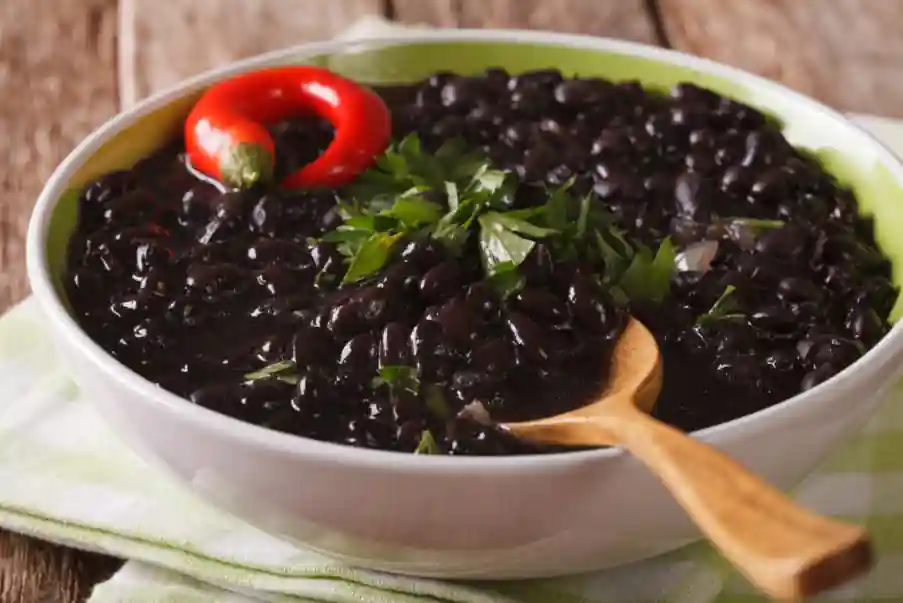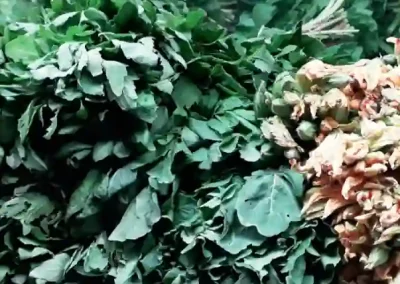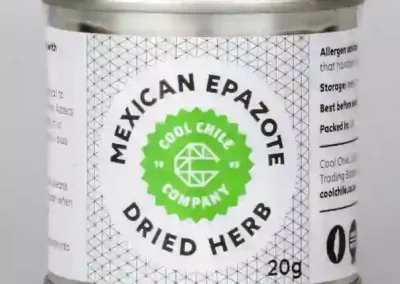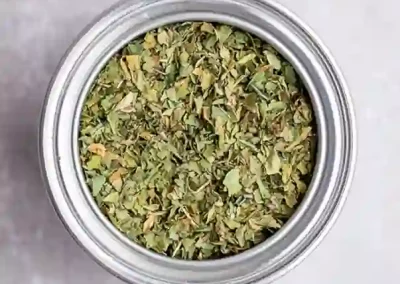Authentically Mexican Black Beans
Beans have been a staple of traditional Mexican and other American societies since antiquity. Paired with maize or corn they’ve been providing complete protein and energy to entire civilizations for millennia. Black beans are also rich in micro-nutrients, with plentiful amounts of folate, vitamin B1, iron and magnesium
Here in Europe, we tend to think of refried Mexican beans, that réchauffé of beany nectar days in the making, sautéd with garlic, chilli, cumin and aromatic herbs and spices, more delectable with each day it matures
Yet, delicious as they are, before refried beans comes the mother-dish, Olla de frijoles. Deep and subtle, succulent little parcels are steeped in a broth of garlic and sweet onion, and brought together by the unique aroma of epazote (Dysphania Ambrosioides), an herb known in Europe as wormseed and reputed, among other things, to bring relief from any tiny tendency to flatulence
Ingredients For Cooking Traditional Mexican Beans
Black Beans
Beans are legumes, a classification which includes peas, lentils, and also peanuts. Of the different types of black beans, black turtle beans are the commonest and most readily available. Feel free to use any black beans of your choosing, bearing in mind that different varieties may require different cooking times
Epazote
After the beans themselves, Epazote herb provides the quintessential backbone of traditional Mexican black beans. Epazote is ubiquitous in Mexican cuisine and one of its defining tastes, and well worth trying to source. The herb can be easily grown from seed in warm and temperate climates. Otherwise the dried herb keeps its flavour fairly well
In the UK, you can get this most Mexican of herbs from the Cool-Chile-Company (http://coolchile.co.uk) and other Mexican shops online. Not forgetting amazon, of course
Onions And Garlic
Not uncommonly, Mexican cooks skip sautéing onions and garlic, instead charring them on a dry skillet, or adding them raw to tomatoes and chillies to form a purée. This is the most common approach when preparing home-made Mexican black beans
Simply peel and quarter the onion and top and tail a whole garlic bulb to reveal some of the flesh, then add both to the pot
Variations To Enhance Your Dish
Herbs And Spices
As with all world cuisines, Mexican cuisine is regional and subject to no end of variations. If you can’t get hold of epazote, don’t worry. You can make excellent Mexican black beans using lots of other herbs and spices.
Dill, for example, has aromatic qualities I think are sympathetic to epazote, and is my personal favourite alternative. Add the dry herb to the raw ingredients, or the fresh roughly chopped fronds at the end of the cooking process
Other herbs you can use include tarragon for that aniseed sweetness, or more robust herbs like oregano and thyme for a high savoury note. Parsley makes a good pairing with the last two: tie up the stalks and add them to the raw ingredients. Then, remove them and add the roughly chopped leaves at the end of cooking
You can also add in any of your favourite spices, such as cumin or fennel. Dry-roasted then roughly ground in a mortar and pestle is best
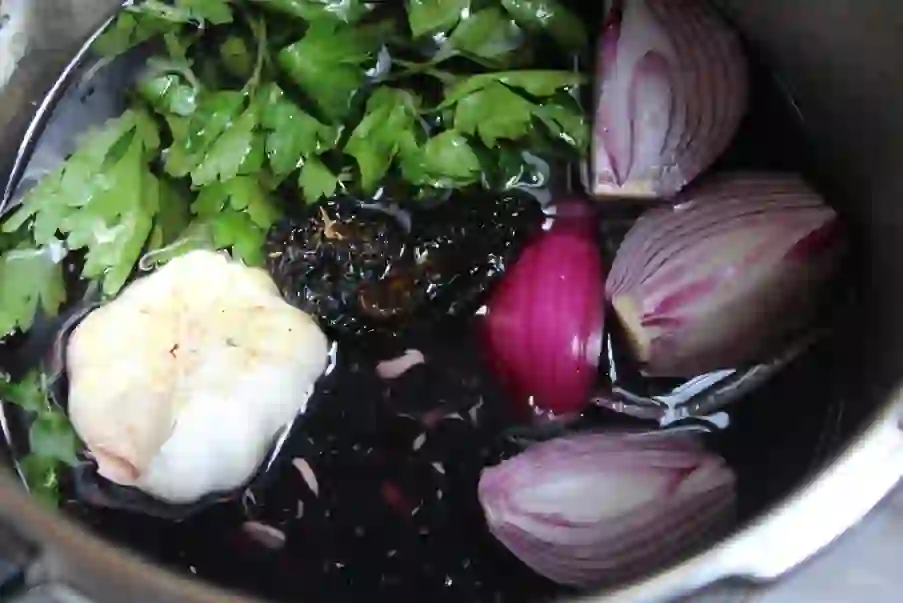
Chillies?
The most traditional bean recipes like the abuelita (grandma) used to make don’t usually include chillies. My Mexico City friend Claudia Regina adds sautéed green tomatillos and green serrano chillies, while her sister Angelica uses smoky chipotles or morita with pinto beans and ancho, pasilla or guajillo chillies with her black beans
I like chipotles with all Mexican bean dishes. The recipe below also uses a large ancho chilli. You can omit both, or enjoy some smokiness without the heat using sweet Spanish La Vera paprika
Tomatoes & Tomatillos
While tomatoes don’t feature in the most “traditional” Mexican bean dishes, they can certainly add richness to the dish
I’ve seen my friend Claudia Regina (she lives in beautiful Coyoacan, in Mexico City) use green tomatillos hich she sautées with onion, garlic and some bay leaf in olive oil
NOTE
Lest I get told off by Claudia, I feel bound to mention that in Mexico, home to the tomato, red tomatoes are referred to as Jitomates, while green tomatoes, which are not tomatoes at all, but related to the Cape Gooseberry, or Physallis, come in the larger Tomate and the smaller Tomatillo varieties. Make of that what you will
Cooking Up the Perfect Beans
Preparing homemade Mexican black beans is not difficult. But achieving perfection requires some attention to detail and a bit of culinary know-how. Here are a few tips to ensure your beans are not just flavoursome, but also cooked to perfection
Soaking
Soaking is essential for any good bean dish. While there are time-saving hacks like using a pressure cooker soaking remains the method of choice. Soak the beans for at least 8 hours, or overnight. Apart from reducing cooking time and yielding the best texture, soaking also helps remove indigestible sugars that can cause gas, and other anti-nutrients that can reduce the nutritional content of your dish
Sautéing?
While traditional beans don’t pre-cook the onions and garlic, sautéing both in a little oil certainly enriches and develops their flavour. Take your time to cook them until they develop a golden color. Add dried herbs and spices to halfway through the sautéing process to allow the herbs and spices to release their aromatic oils for maximum flavour
Simmering
Perfect Mexican black beans take time to develop their flavour. Cook them on a low heat over a long period. Once the beans have come to a boil, turn the heat to low and simmer gently for at least an hour, and probably longer. This slow cooking process allows the flavors to meld together and ensures tender, creamy beans.
Most cooks add salt towards the end of cooking. Adding salt to the beans too early tends to toughen their skins. Maybe you want a firm bean with a wonderfully tender and savoury centre? On the other hand, adding slat too late makes for a rather bland bean in a rather salty broth. As with everything, it’s about getting a balance and pleasing your palate. There’s room for experimentation here
Pressure Cooking
I’ve made great Mexican black beans in the pressure cooker. Admittedly, they’ve been better the next day, and heavenly the day after, and that’s before re-frying. But that’s the natural order of things
While pressure cooking will take care of even dry, unsoaked beans, I don’t recommend it. The result can be an uneven cook with some beans turned to mush while others remain “crunchy”!
Bring to the boil on a high pressure setting until steam escapes, then simmer your beans on a low flame at high pressure for just 7-8 minutes. Turn off the flame and let pressure normalize naturally, with the weight or valve still applied
The beans should still be a little firm and there may be excess liquid. This is a good time to season with salt, then simmer just partially covered until the beans are tender and most of the water has evaporated. Alternatively, if the beans start to run dry, have a kettle of very hot water handy to top up your beans
Storing And Reheating Mexican Beans
The best Mexican style black beans are a day (or two) old! As soon as the beans reach room temperature pop them in the fridge. The following day cook, covered, at medium high heat for around 10 minutes adding sufficient water to prevent the beans sticking or burning.
Réchauffé: Refried Mexican Black Beans
This is probably the most exciting stage of your beans’ journey. You can really let rip here and incorporate some of your favourite condiments.
Sautéing the condiments is obligatory. While Mexicans love using manteca, or pork dripping, we veggies can stick with olive or any other good oil. Sauté garlic, plenty of it, fresh or dried chillies, especially smoky chipotles, or La Vera Spanish paprika for a milder hit.
Add herbs such as oregano, marjoram, thyme, even rosemary. I love cumin, but not so much with my beans. You might beg to differ. I love corander. But Mexicans say coriander kills epazote. I think they’re right. On the other hand, if you haven’t used epazote, and even if you have, go for it!
Click the link for a detailed step-by-step guide to cooking up Mexican refried black beans to perfection
Serving And Pairing Suggestions
Mexican black beans are fantastically versatile and can be enjoyed in lots of ways. Here are a few serving and pairing suggestions to elevate your veggie table:
1. Side dish: Mexican beans are a delicious side dish with any Mexican-inspired meal. In fact, any meal at all. They pair particularly well with all corn-based dishes like enchiladas and tacos, and also with tamales
2. Beans can be used as a filling for tlacoyos: a doble-layered, oval tortilla with a bean centre. I’ll be sharing a recipe for these very shortly. Meanwhile, here’s a link to another page with a nice recipe for tlacoyos
3. Enfrijoladas: Use refried beans loosened with vegetable broth to coat soft corn tortillas, fill them with something yummy, then fold or roll them onto a serving dish. Add your favorite toppings such as soft crumbly feta, or a hard cheese for melting under the grill. Top with your favourite salsa and enjoy
3. Mexican black bean soup: Puree the cooked beans with some vegetable broth to create a hearty and nutritious bean soup. Spice it up with chipotles in adobo or La Vera Spanish paprika, and top it with a dollop of sour cream or non-dairy yoghurt, chopped coriander, and a squeeze of lime for an extra burst of flavour.
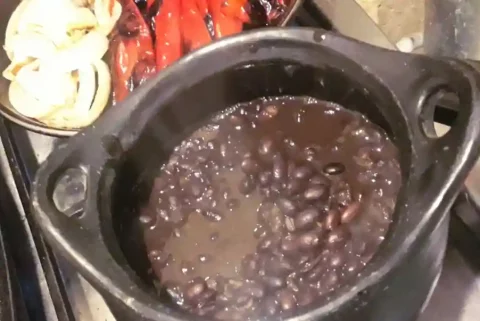
- 2 cups black beans Soaked overnight
- 1 large onion peeled & cut in four
- 1 bulb garlic topped & tailed to expose the flesh
- 1 bunch epazote or 1 tsp dried
- or flat leaf parsley & tarragon
- 1 whole ancho or Pasilla chilli (optional) Or 2 Kashmir Chillies
- 1 whole chipotle or morita chilli (optional) Or 1/4 tsp smoked paprika
- 2 Bay leaves Optional
- Salt to taste
- Put the drained, pre-soaked beans into a large pot. Add all the other ingredients except the salt & cover with water
- Cook for 30 minutes in a pressure cooker or up to 90 minutes in a conventional pot
- Remove the garlic remnants & bay leaves anf season to taste
- The beans should be very tender but hold their shape and the liquid should be thick enough to coat the beans. Cook for a little longer if necessary to achieve this consistency
Notes
Nixtamalization Of Corn: Secret Of Ancient America
Mexican Refried Black Beans
Baked Beans À La Différence
Roasted Tomato And Garlic Soup With Figs
Home Page
Subscribe To Posts

